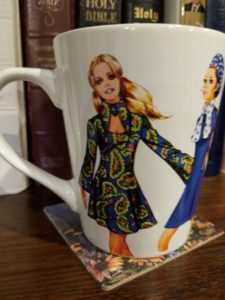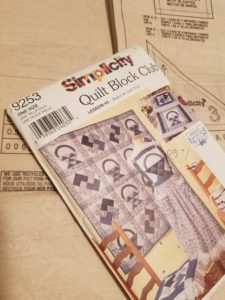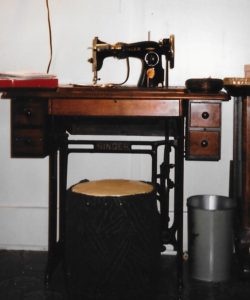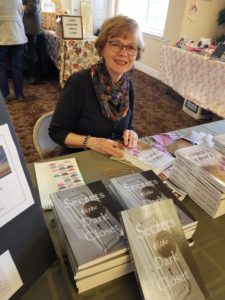Simplicity
If you receive this by email, please click on the title of the post and read it on the website.
 The display of mugs with Simplicity pattern artwork in a local fabric shop surprised and delighted me. Along with the mugs, there were notepads, aprons and tea towels imprinted with the retro images of young women wearing stylish clothing from other eras.
The display of mugs with Simplicity pattern artwork in a local fabric shop surprised and delighted me. Along with the mugs, there were notepads, aprons and tea towels imprinted with the retro images of young women wearing stylish clothing from other eras.
The items evoked so many memories that I immediately purchased several pieces.
I haven’t sewn much for a dozen years. The Pfaff sewing machine I bought for retirement sits idle in a closet; the Simplicity pattern I used to make pajamas for my sons and grandsons is stashed somewhere in a container.
Still, using patterns to construct clothing may be a dormant part of my DNA. I come from a long line of seamstresses with exacting skills. As I grew up, my mother made all of her clothes and mine. Dresses, shirts, pants and pajamas. One year she even sewed a winter coat for me. No doubt with a Simplicity pattern.
I clearly remember how fussy she was about the fabric she purchased. It had to be strong and durable, and it seldom cost over a dollar a yard. After being well used as clothing, it was turned into quilts or rugs. I still have doll quilts that she made out of our old dresses. My dolls had the best wardrobes.
After she selected the fabric, matching thread, and any needed buttons, zippers, binding or rickrack, she would set about making an article of clothing. The first step was to wash the fabric in case it tended to shrink. It was then pressed free of wrinkles.
Mom usually began the actual construction after a meal, when the kitchen was quiet. First, she cleared the oblong oak table of its standard sugar bowl and toothpick holder. Then she laid out the fabric on the table, and the tissue pattern pieces on top of the fabric. She put glasses on top to hold them in place in case someone blew in the kitchen door. Finally, she put stickpins around all of the edges.
Before the scissors ever made it out of the sewing machine drawer, she checked everything twice. Measure twice, cut once might have been her motto. Mom had special stainless steel scissors used only for cutting material. As I remember it, the penalty for borrowing them was so severe that no one ever dared use the scissors as a screwdriver or to cut out newspaper stories.
When I joined 4-H, she bought me a child-sized scissors that fit my hands. Eventually, when I was responsible enough, she gave me full-size scissors, which I still use. Responsibly.
Once Mom cut the fabric along the pattern lines, she moved on to the sewing machine. Hers was a treadle machine purchased on credit during the desperate 1930s. Somehow, she had squeezed five dollars a month out of her egg and cream money to buy that machine. The papers remained in one of the drawers as long as she lived.
 She lifted the machine from the cabinet and put it in a working position. Then she took one of the three bobbins she used for decades and filled it with thread.
She lifted the machine from the cabinet and put it in a working position. Then she took one of the three bobbins she used for decades and filled it with thread.
When both the bobbin and the spool of thread were in place, she’d check the needle. You couldn’t do a good job with a dull needle or one that was the wrong size for the type of fabric.
Then, she set the tension on the machine. The tension between the needle and the bobbin must not be too tight or too loose, or the stitches wouldn’t be right. She also checked the presser foot and set the stitch length before lowering the feed dog onto the fabric.
Mom sew hundreds of items during my growing up years. Then, in high school I finally went through the process myself: choosing fabric, cutting it according to the pattern, basting seams, and sewing them. I have clear memories of our teacher standing over me while I ripped out a less-than-perfect seam. And happy memories of wearing lined wool dresses that I made.
There were no shortcuts when it came to sewing a quality garment. The pattern had to be laid out straight so the seams matched. Otherwise, my pretty summer dress might have roses that went this way and that way. As you sewed it, the pattern’s dark blue notches, numbers and cryptic instructions had to line up. The buttonholes needed to be in a straight line and the buttons set in the same direction. Seam tape, binding and zippers had to be sewn perfectly.
Sewing requires patience. To skip one of the steps is to invite disaster. A garment can be ruined by shoddy workmanship, such as a crooked seam or a lopsided collar. However, creating something beautiful is a matter of simply taking your time and following the steps of the pattern. The process is important, right down to the last stitch in the hem.
There are many types of patterns to follow. Any creative process, from making clothing to woodworking, to designing buildings, requires a pattern or a master plan.
However, the most important patterns have nothing to do with clothing or wood or buildings. They are the patterns we follow in making decisions every day. If you want simplicity in your life and want good results from your decisions, follow the plans of the Master Pattern Maker.
“If any of you lacks wisdom, you should ask God who gives generously
to all without finding fault, and it will be given to you.” James 1:5 (NIV)
Writing Update
 Almost every day someone asks if I’m working on my next book. The answer is…maybe!
Almost every day someone asks if I’m working on my next book. The answer is…maybe!
For now, I’ve been out and about signing copies of Amber’s Choice. The downside of that is there isn’t much time to write. The upside is meeting so many people who buy copies because they enjoyed By the Banks of Cottonwood Creek and Secrets of the Dark Closet.
If you haven’t purchased your copy yet, it’s available locally and online, in paperback and in eBook. And if you know someone who loves to read, your recommendation is the best kind of publicity.
To all of my readers: Thank You and God Bless You!

